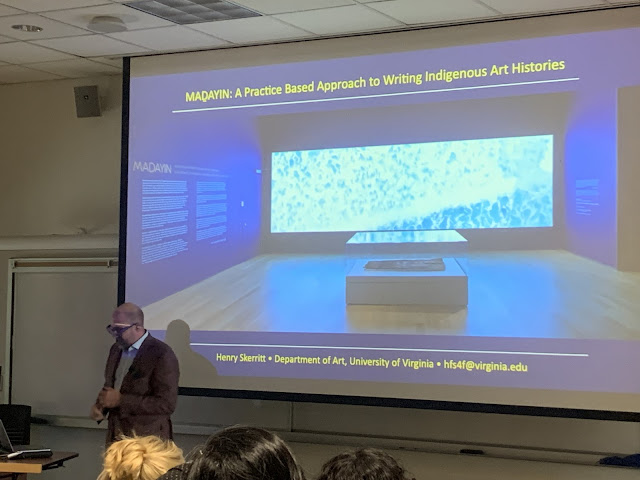Dr. Henry Skerritt: MADAYIN: A Practice-Based Approach to Writing Indigenous Art Histories; Twentieth Annual Festival of the Arts Art History Symposium and Artist Lecture: Towards a Multiple Worldview; Remapping Paradigms of Modern and Contemporary Art
April 19, 2024
Art History Speaker:
Henry Skerritt, Assistant Professor, University of Virginia and Curator of Indigenous Arts of Australia at the Kluge-Ruhe Aboriginal Art Collection of the University of Virginia. introduced by student Sadie Odell
“MADAYIN: A Practice-Based Approach to Writing Indigenous Art Histories”
Sponsored by the Department of Art, University Galleries, Center for Teaching and Learning, and the College of Arts and Letters. In honor of Dr. Elaine O'Brien.
Welcome remarks were made by the Dean of the College of Arts and Letters Dr. Sheree Meyer and the Chair of the Art Department, Rachel Clarke.Dr. Henry Skerritt's presentation at the 20th Annual Art Symposium covered Skerritt's collaboration with the Yolngu Aboriginal culture to create the Fralin Museum of Art's "Madayin: Eight Decades of Aboriginal Australian Bark Painting from Yirrkala" exhibit.
The word "Madayin" translates to meaning something extremely beautiful, sublime, and-- mainly-- sacred. The connections made by the Yolngu artists through the structure, representation, and imbued belief system embody this idea of Madayin. In this way, the artists and group have made the museum space something to be shared with others on the Yolngu's terms.
Skerritt worked directly with clan members and emphasized their adoption of the curator position when working alongside him to create the exhibit in an inclusive and representational way that was truly respectful of the group's culture. The Yolngu artists are part of a living culture and "Maddayin" is imbued with the preserved ancestral techniques the group practices in contemporary times. Skerritt's implementation of the lifestyle of this group was led by co-curator and Yolngu leader W. Wanambi who took charge of directing the cultural significance of each vital aspect to the Yolgnu system of beliefs.
Skerritt was asked by an audience member, “Do you have any apprehension putting sacred objects in a space that is so sanitized and Western?" In reference to the white queue gallery space.
To which he replied that one important thing to note is that every single one of those paintings was made for the world and for that context. An important part of that process was taking over that space. The museum can be seen as an impenetrable object that can only be seen in a singular way, but Yolngu see it as a space of power that they can occupy. These works are made specifically for that space and how much information is being able to be shared with the museum. Outsiders can look at designs to look at the beauty and not understand the deep meaning similar to the child Yongu. They are well attuned to the idea of gradual communication. Rather than stating something can't be talked about, they are shared gradually for those who are like children.

.jpg)


Comments
Post a Comment